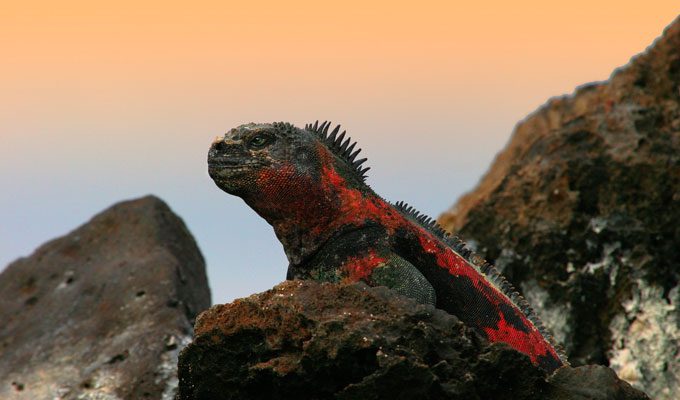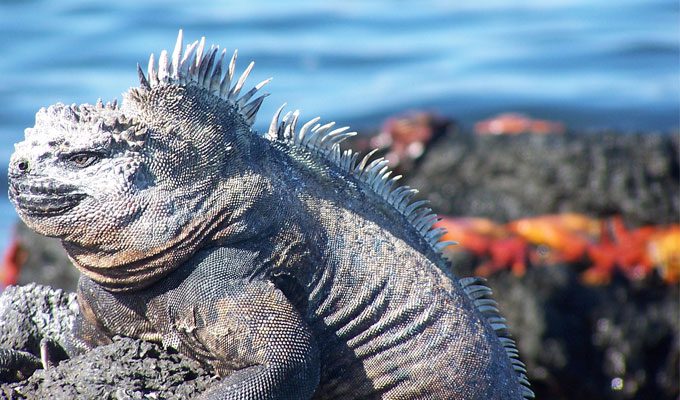When Charles Darwin visited the archipelago, he mistakenly gave little importance to the Galapagos marine iguanas and even though they were “hideous-looking…most disgusting, clumsy lizards.” However, these miniature swimming dragons are a spectacular example of the processes of evolution and are remarkably well-adapted to their environment.
TALK TO A DESTINATION EXPERT

Diego Zapata

Rosa Mena

Sandy Lara

Diego Zapata

Rosa Mena

Sandy Lara
General description
The first iguanas are thought to have arrived at the Galapagos Archipelago several million years ago (possibly even 10.5 million) via piles of debris or logs that were caught up in ocean currents. The iguana has since evolved into several different species and is currently one of the most prominent animals on the islands. There are only one species of Galapagos marine iguanas in the archipelago, but as is often the case in this archipelago, it varies slightly in color and size between islands, with a total of seven subspecies recorded. When exploring the islands, visitors can most easily differentiate subspecies based on their color. For example, Española Island is known for hosting the most colorful subspecies (primarily turquoise and red), nicknamed the Christmas iguana, while those on Santiago are predominantly green. Marine iguanas can also be easily spotted at Punta Vicente Roca.
Get a close look at the iconic Galapagos Marine Iguana!

More specifically, Galapagos marine iguanas can easily be recognized from land iguanas by their laterally flattened tail, wide-set eyes, salt-encrusted heads, and flat and square nose. Males tend to be slightly brighter than females, with larger bodies and can grow over four feet long. The spines along their backs are also slightly longer and during the mating season they get significantly more colorful (particularly the Christmas iguanas).
The world’s only sea-going lizard
The marine iguana split from its ancestor approximately 5.7 million years ago, thus it has had time to properly evolve those features that distinguish it from every other lizard in the world. Once the marine iguana realized there was a ready and abundant source of food on the ocean floor, it evolved to better exploit this. Its flattened tail serves as a rudder, propelling it below the ocean surface to feed on the algae that grow on the rocks. Its long claws allow the lizard to cling to rocks on the ocean floor as it scrapes off the algae with its sharp teeth and flat nose. In fact, these lizards have become so well adapted to their marine environment that they are able to stay underwater for up to an hour, although dives generally do not exceed five or ten minutes.
Remarkably, Galapagos marine iguanas have not only evolved to become spectacular swimmers but to deal with the salty, cold waters where they feed. Like all reptiles, iguanas are cold-blooded and so cannot thermoregulate their body temperature. Because of this, the iguanas must sit in the sun to raise their body temperature to 36°C before entering the water to feed, as they can lose up to 10°C when feeding. Thus, their dark coloring is key to their health and allows them to absorb more sunlight. On the other hand, due to high salt intake from their food, they have developed an intriguing mechanism to release salt from their bodies. Special glands linked to their nostrils remove high levels of salt from their bloodstream, which the lizard is then able to sneeze out. Sneezing iguanas are a common sight in the Galapagos as a result.

Galapagos marine iguanas also have an exceptionally unique adaptation to food shortages. The climate oscillation is known as El Niño strongly affects the Galapagos climate and ecosystems every few years, during which time the iguana’s primary source of food, algae, dies out in large quantities due to increased water temperatures. The iguanas are hugely affected as a result, but quite remarkably the iguana’s body reacts by shrinking in size until food sources increase, as smaller bodies require less energy. There is no other known case in the world in which an adult vertebrate is able to shrink, particularly in which it does so repeatedly. Scientists believe that the iguana actually consumes its bones to stay alive, resulting in a reduced skeleton.
Recent developments of the Galapagos marine iguanas
In recent years, experts in the islands have observed the iguanas consuming grasshoppers, crustaceans and land vegetation to survive during particularly strong El Niño events. Evolution is a continual process, and it appears the lizards are adapting their behavior to survive during hard times.

Javier Garcia

Eduardo Silva

Carolina Escobar
START PLANNING YOUR TRIP

Javier Garcia

Eduardo Silva

Carolina Escobar
Get in touch for more
CONTACT US


